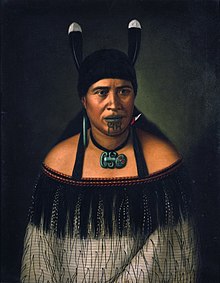Huia
| Huia | ||||||||||||
|---|---|---|---|---|---|---|---|---|---|---|---|---|

Female, specimen in the Wiesbaden Museum |
||||||||||||
| Systematics | ||||||||||||
|
||||||||||||
| Scientific name of the genus | ||||||||||||
| Heteralocha | ||||||||||||
| Cabanis , 1851 | ||||||||||||
| Scientific name of the species | ||||||||||||
| Heteralocha acutirostris | ||||||||||||
| ( Gould , 1837) |
The Huia or Lappenhopf ( Heteralocha acutirostris ) was one of the only New Zealand popular rag birds and is regarded since 1907 as extinct . He reached a size of up to 55 centimeters. In particular, the sexual dimorphism was pronounced in this species. The females were not only larger, they also had a narrow beak up to 8.5 centimeters long, which was woodpecker-like in the male and significantly shorter at only 6 centimeters. Since such a clear difference from no other bird species is known, its origin is controversial.
In the overall representation of the birds of the Australis , Gould (1865) lists the Lappenhopf under the name Neomorpha gouldi Gray, 1841 and repeats Dieffenbach's description of a hunt for the animals which, because of their tail feathers, served the Māori as important game and commercial goods. When hunting, the Maori used a long, high-pitched shout that was similar to the name Huia and which attracted the animals. Edgar Leopold Layard reported in 1863 about the rarity of the bird, which is now missing in large parts of New Zealand. Certainly, the European-style agriculture and the large loss of area of the forests finally brought about the extinction. The special fashion in the western world at the end of the 19th century also resulted in additional hunting pressure on numerous exotic bird species that have special decorative feathers.
According to reports by the Māori, the Lappenhopf, which is widespread in the northeast of the North Island of New Zealand, also occurred in historical times on the South Island, where it could no longer be seen by European researchers. The animals preferred the dense mountain forests at least at the end of the 19th century. The reports and the particular anatomy (long legs) suggest that it was a moderately gifted aviator. The birds, which usually appear in pairs, jumped from branch to branch and could also be observed on the ground. Seeds, berries and insects served as food. The beak of both sexes was certainly very suitable for looking for insect larvae in wood; it is possible that males and females complemented each other through the different texture of their beaks. The nests in hollow trees, which contained two to three spotted eggs, are also known. The young were looked after by both parents.
literature
- J. Gould: Handbook to the Birds of Australia. Volume 2. London 1865, pp. 530-532.
Web links
- Heteralocha acutirostris in the endangered Red List species the IUCN 2008. Posted by: BirdLife International, 2008. Accessed January 2 of 2009.
- Nga Huia . New Zealand Birds,accessed December 25, 2015(website contains an audio sample of the bird's song).

